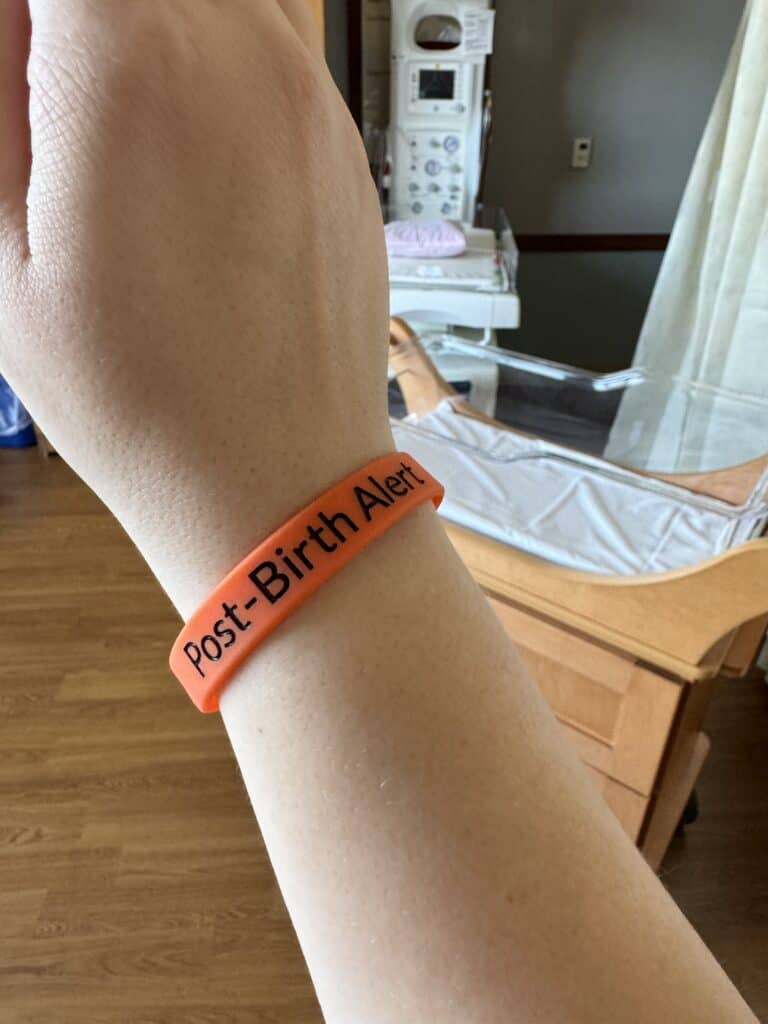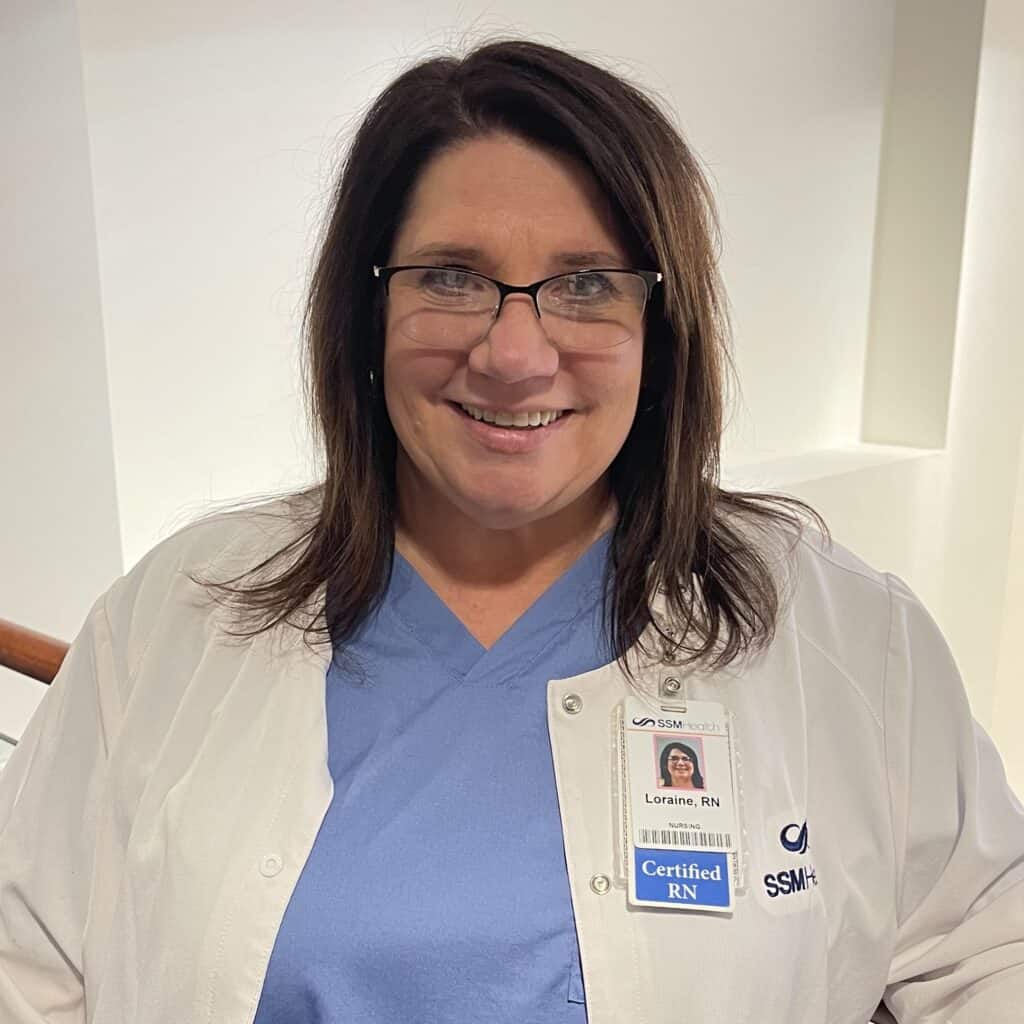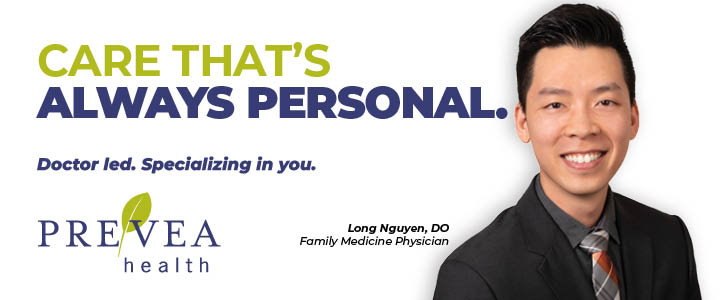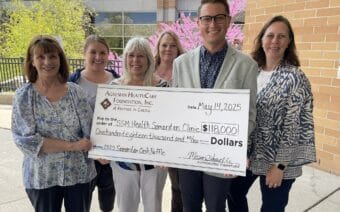
February 24, 2025
FOND DU LAC – SSM St. Agnes Hospital is doing what it can to further support the health and recovery of its postpartum patients with a blaze-orange bracelet that has the potential to save lives.
Loraine Carley – a certified registered nurse and manager of women’s health at St. Agnes in Fond du Lac – said the hospital recognized there was more work to be done to protect patients from postpartum-related illnesses and conditions.
In 2022, the CDC (Centers for Disease Control and Prevention) reported 817 women dying from maternal-health-related causes – two-thirds of which were considered preventable.
And the U.S., Carley said, has one of “the highest rates of maternal mortality” among developed countries.
“That’s a huge volume of 800-plus women that die from postpartum complications,” she said.
Carley said the country’s first post-birth alert program was piloted by a husband and wife in Florida after the wife experienced delays in receiving potentially life-saving care while waiting in the emergency room.
“A woman who came into the ER, who had a baby (recently), whose husband is a paramedic, was having stroke-like symptoms,” she said. “They took her in, and by the time she was seen, she was having a stroke, and (the husband) said, ‘There’s got to be a way to let EMS and hospitals know a woman had a baby (recently).’”
So, Carley said the couple came up with the idea to distribute bright-orange bracelets to postpartum mothers so if, or when, she experiences any kind of symptoms, EMS and hospital staff know to check for specific conditions.
That program has made its way to Wisconsin, with SSM St. Agnes being the first in the state to distribute post-birth alert bracelets to its patients.
“One of my peers – (Michele Schiess, director of acute care and emergency services at SSM Health Monroe Clinic Hospital) – was very passionate about this,” she said. “So, she approached all the leaders, and we were like, ‘Of course, this is a great program to get started in Wisconsin.’”
Postpartum medical risks
The reason women are at a greater risk for medical complications following pregnancy, Carley said, is because of the drastic changes a mother’s body goes through.
“Your body changes so much,” she said. “Your blood volume almost doubles because it prepares for blood loss (during birth).”
Those changes and the potential problems they cause, Carley said, can linger “six to eight weeks” as women recover following giving birth.
Things like swelling of the body – particularly the ankles – “headaches not going away by Tylenol” or “visual disturbances,” excessive bleeding and hemorrhages can be signs that a mother is experiencing a postpartum medical event.
“We do a lot of (education) with our moms to say, ‘Hey, these are things you should be watching for,’” she said.
But Carley said that only goes so far.
Now, along with the instructions and bracelets, she said new mothers are given a sheet of paper containing information – in both English and Spanish – they need to know to recognize when they are experiencing a postpartum medical event.
“Our nursing governing body – the Association of Women’s Health Obstetrics and Neonatal Nurses – we put this together, and we have (mothers) hang this sheet on their refrigerator for six weeks,” she said.
Since the post-birth alert program was implemented at the beginning of the year, Carley said St. Agnes has had more than 60 births, and that parents have reacted positively to the program.
“It’s been very well received… (and) my expectation of the staff is that they go through this right at discharge with them,” she said. “We’re auditing it, (too). We call from the clinic to say, ‘Hey, who’s all wearing it? And if you’re not, why?’ I think for the most part, there’s been a lot of embracing of it and accepting that, ‘Oh, yeah, that’s a great idea.’”

Education for the mothers is important, Carley said, but even more important is ensuring EMS and ER providers understand what the orange bracelet means in terms of how they should care for the patient.
Michael Grahl – EMS medical director at St. Agnes – Carley said, was the conduit to educate first responders on the new program and what the post-birth alert bracelets mean.
“We met with him… and (the) education is basically the same as we give the moms,” she said. “Here’s what we’re teaching moms, here’s the things to be aware of, what are the complications and what are some of the high risks.”
Some of the high-risk complications Carley said mothers and providers are educated on through this program are “hypertensive disorders in pregnancy, whether that’s preeclampsia or she has a seizure, and now it becomes eclampsia… any kind of clotting, leg clots, pulmonary embolus, sepsis, signs of cardiac failure, (etc.).”
“We’ve been seeing an increased volume of women having a cardiomyopathy postpartum within the state,” she said.
In addition to educating EMS providers and mothers on potential medical complications, Carley said the program also addresses the postpartum mental health risks mothers can often experience.
“Postpartum depression (and) postpartum psychosis – where you think about hurting your child, you think about hurting other people – and then people who would turn to substance use for their postpartum anxiety, which we see a lot of,” she said. “Women who have just had a baby are very susceptible to these things.”
Nationwide initiative
Carley said though St. Agnes is the first in the SSM Health System to introduce the program, there are plans to “bring it to the rest of our perinatal group” over time.
“You start to feel like, ‘wait a minute, if there’s one thing that we could do, it would be this,’” she said. “Because we’ve had, here in Fond du Lac, a couple of moms have a stroke postpartum… or a seizure from preeclampsia.”
Another way health systems in the state and across the country are combating postpartum conditions, Carley said, is by redefining what the appropriate blood pressure range is for women who recently gave birth.
“As a nation, we’re looking at parameters (set by) ACOG – which is the American College of Obstetrics and Gynecology,” she said. “It looks like our numbers are higher for women who have more preeclamptic issues or more prenatal issues. And the reason is, we’ve learned that women have a threshold with their blood pressure of where they’ll have a stroke.”
Carley said what is considered an acceptable blood pressure in any other healthy adult, could actually lead to a stroke in a woman who recently gave birth.
“People that come in the ER with a blood pressure of 150 over 90, they think, ‘Oh, well, that’s awesome,’” she said.
However, if the patient is a woman who has just had a baby and the providers aren’t aware of that, Carley said they wouldn’t know that her blood pressure actually needs to be much lower than what’s considered acceptable for any other adult.
“They’re going to have to rethink how they’re treating her and say, ‘Oh, we want her under 140 because she’s young and she’s healthy,” she said. “The severe range for a pregnant woman is 160 over 110 because that’s where women are having strokes.”
Carley said that’s where the bright orange post-birth alert bracelet comes in – to visually inform EMS, ER and other healthcare providers that symptoms a woman is experiencing need to be considered within the context that she has recently given birth.
“That’s the purpose of the band, and thus the color,” she said. “I had a couple of people say, ‘Why can’t they be like a pretty color?’ They’re not meant to be a pretty color, because they’re meant to be ‘emergency orange,’ like a Medical Alert Bracelet.”
The visual signal, Carley said, can also be for the woman, as some don’t always think about or attribute their symptoms back to having a baby.
“You think, ‘Oh, I have a headache because I’m tired,’ (or) ‘I have double vision – must be tired,’” she said. “In reality, you could be having a medical event.”
Another advantage of the bracelets, Carley said, is that if a woman is experiencing a postpartum-related medical event she may not be able to tell EMS or ER providers that she has given birth.
“Maybe they passed out or had a seizure, or are having some medical event and they’re not responsive,” she said. “How is anybody supposed to know they just had a baby? This will alert EMS and alert the ER that she can’t wait in the waiting room with everybody else.”
‘In it for the same reason’
Carley said regardless if a mom is delivering with SSM, any interested parents-to-be can reach out and request a bracelet.
“Really, the thing I love about this program is it’s really not just who can do it first,” she said. “So, I don’t care if they’re not delivering here – I will give them a bracelet so they can wear it to let people know that they had a baby until all of our healthcare colleagues get this program implemented to where it’s statewide.”
Implementing the program statewide, Carley said, is something she and other providers – at SSM and beyond – are working to achieve.
“It was great that we brought it to Wisconsin, but again, it’s about our moms in the community,” she said. “And so, when you put all of our competition aside in hospitals, we’re all in it for the same reason – which is to have healthy moms and healthy babies.”
 Creating spaces where people can unwind, appreciate world around them
Creating spaces where people can unwind, appreciate world around them ‘This recognition a testament to hard work and dedication’
‘This recognition a testament to hard work and dedication’








